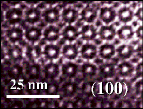Sensors' New Clothes Enhance Efficiency
Kevin RobinsonALBUQUERQUE, N.M. -- A new coating for chemical sensors promises to increase their sensitivity by a factor of 500. The porous coating, developed at Sandia National Laboratories, is less than 1 µm thick, but its extremely high surface area makes the device more sensitive to dangerous or deadly chemicals such as the nerve gas Sarin.

The regular arrangement of the pores on a new coating developed by Sandia National Laboratories acts as a tiny filter and can enhance the sensitivity of chemical sensors. |
Celeste Drewien, a researcher at Sandia, said the coating can increase sensor sensitivity in two ways: by providing a larger surface area for adsorption and by creating more passageways through which certain chemicals can pass. The pores in the coating act as a kind of filter to screen out molecules based on their size. Because the scientists can control the size of the pores, they can use molecular size to discriminate among the chemicals they want to detect.
Scientists can make the pores' surface hydrophobic, hydrophilic or analyte-specific, depending on the application. They are currently preparing the coating with dispersed silver nanocrystals, which are known for their ability to enhance IR effects.
The substance is made by a dip coating method. A substrate is repeatedly dipped into and removed from a solvent solution. As the solvent dries, the nanocomposite coating forms without seams. The seamlessness of the coating is important because fractures in the coating would negate the filter's effects.
LATEST NEWS
- CLEO Heads to the East Coast Apr 29, 2024
- Laser-Based Gas Analyzer Developed to Detect Air Pollution Apr 29, 2024
- Qubits Could be Stored in Flash-Like Memory Apr 29, 2024
- Exail Signs LLNL Contract, Partners with Eelume Apr 26, 2024
- Menlo Moves U.S. HQ: Week in Brief: 4/26/2024 Apr 26, 2024
- Optofluidics Platform Keys Label-, Amplification-Free Rapid Diagnostic Tool Apr 25, 2024
- DUV Lasers Made with Nonlinear Crystals Enhance Lithography Performance Apr 25, 2024
- Teledyne e2v, Airy3D Collaborate on 3D Vision Solutions Apr 24, 2024
